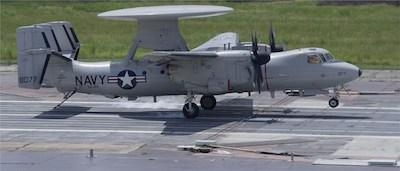Fri, Oct 12, 2018
Prerequisite For Carrier Operations Aboard The USS Gerald R. Ford
Advanced Arresting Gear (AAG) performance testing has been successfully completed for the C-2A Greyhound, E-2C+ Hawkeye, and E-2D Advanced Hawkeye aircraft by General Atomics Electromagnetic Systems (GA-EMS). The testing supports the Navy’s development of a propeller Aircraft Recovery Bulletin (ARB), which is a prerequisite for arresting propeller aircraft aboard USS Gerald R. Ford (CVN 78). The Navy completed the performance testing of the GA-EMS system on the Runway Arrested Landing Site (RALS) at Joint Base McGuire-Dix-Lakehurst in New Jersey.

“The AAG system is designed to arrest a broader range of aircraft and provide higher reliability and safety margins for the U.S. Navy’s Ford-class of aircraft carriers,” stated Rolf Ziesing, vice president of Programs at GA-EMS. “As each aircraft is brought in for testing, AAG continues to perform reliably, arrestment after arrestment. The successful turboprop arrestments at RALS mark another significant milestone that moves the Navy closer to initiating recovery testing for these aircraft aboard CVN 78.”
The AAG system has been exercised extensively, with more than 800 total roll-in and fly-in aircraft arrestments successfully performed at RALS. In addition, nearly double the approximately 400 planned at-sea F/A-18 E/F Super Hornet recoveries during sea trials and shakedown have been completed aboard CVN 78. GA-EMS continues to collaborate closely with NAVAIR and the shipbuilder to optimize the AAG system and the Electromagnetic Aircraft Launch System (EMALS), and support upgrades during the CVN 78 Post Shakedown Availability (PSA).
“We continue to stress the system, analyze results, and tune the system to ensure maximum performance,” stated Dean Key, senior director of EMALS/AAG programs at GA-EMS. “We are on target to be ready for fleet operations when CVN 78 completes its PSA in 2019. We are pleased with AAG’s performance, and remain focused on optimizing the system’s capabilities to meet the daily operations and mission requirements for CVN 78 and the next two Ford-class carriers currently under construction.”
AAG is a turbo-electric system designed for controlled deceleration of aircraft. AAG is installed aboard CVN 78 along with EMALS, which uses electromagnetic technology to launch aircraft from the deck of naval aircraft carriers. Both systems have been successfully tested during at-sea periods aboard CVN 78, and are currently in production for the future John F. Kennedy (CVN 79) and Enterprise (CVN 80) aircraft carriers.
(Image provided with General Atomics news release)
More News
From 2023 (YouTube Version): Legacy of a Titan Robert (Bob) Anderson Hoover was a fighter pilot, test pilot, flight instructor, and air show superstar. More so, Bob Hoover was an i>[...]
Get The Latest in Aviation News NOW on Instagram Are you on Instagram yet? It's been around for a few years, quietly picking up traction mostly thanks to everybody's new obsession >[...]
Aero Linx: B-52H Stratofortress The B-52H Stratofortress is a long-range, heavy bomber that can perform a variety of missions. The bomber is capable of flying at high subsonic spee>[...]
Altimeter Setting The barometric pressure reading used to adjust a pressure altimeter for variations in existing atmospheric pressure or to the standard altimeter setting (29.92).>[...]
"Knowing that we play an active part in bettering people's lives is extremely rewarding. My team and I are very thankful for the opportunity to be here and to help in any way we ca>[...]
 Classic Aero-TV: Remembering Bob Hoover
Classic Aero-TV: Remembering Bob Hoover ANN FAQ: Follow Us On Instagram!
ANN FAQ: Follow Us On Instagram! ANN's Daily Aero-Linx (05.15.24)
ANN's Daily Aero-Linx (05.15.24) ANN's Daily Aero-Term (05.15.24):Altimeter Setting
ANN's Daily Aero-Term (05.15.24):Altimeter Setting Aero-News: Quote of the Day (05.16.24)
Aero-News: Quote of the Day (05.16.24)



